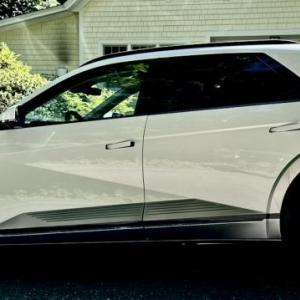More Than a Mere Hatchback: Hyundai Ioniq 5 AWD Limited
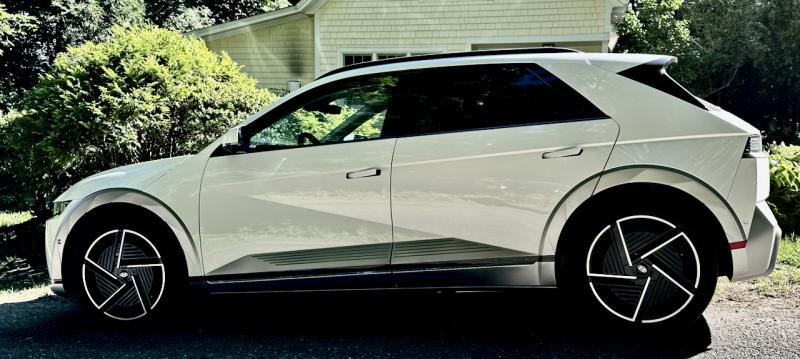 Introduced in 2022, the stylishly edgy Ioniq 5 was updated for ‘25 with more range and faster charging plus a host of detail improvements. The Ioniq 5 is the first Hyundai that can use Tesla power points without an adaptor, adding some 17,000 recharging stations nationwide. This color is Atlas White.
Introduced in 2022, the stylishly edgy Ioniq 5 was updated for ‘25 with more range and faster charging plus a host of detail improvements. The Ioniq 5 is the first Hyundai that can use Tesla power points without an adaptor, adding some 17,000 recharging stations nationwide. This color is Atlas White.
 Improvements to the Ioniq 5 for 2025 include physical buttons for often-used functions and next-generation connectivity and electronics. The touchscreen can be configured to show battery charge and mileage as well as the location of the nearest charging station. The lower of the two knobs behind the steering wheel is the gear selector.
Improvements to the Ioniq 5 for 2025 include physical buttons for often-used functions and next-generation connectivity and electronics. The touchscreen can be configured to show battery charge and mileage as well as the location of the nearest charging station. The lower of the two knobs behind the steering wheel is the gear selector.
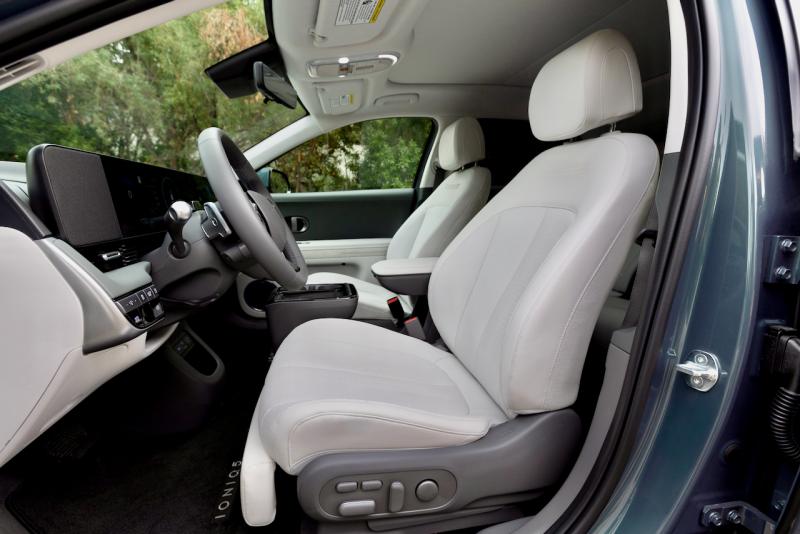 A loaded Ioniq 5 very nearly qualifies as a luxury car. Note the extendable footrest; the passenger front seat has one too. Both front seats also recline—perhaps for a quick nap while the car is plugged in at a charging station on the highway.
A loaded Ioniq 5 very nearly qualifies as a luxury car. Note the extendable footrest; the passenger front seat has one too. Both front seats also recline—perhaps for a quick nap while the car is plugged in at a charging station on the highway.
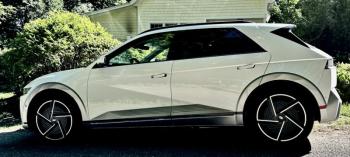 Introduced in 2022, the stylishly edgy Ioniq 5 was updated for ‘25 with more range and faster charging plus a host of detail improvements. The Ioniq 5 is the first Hyundai that can use Tesla power points without an adaptor, adding some 17,000 recharging stations nationwide. This color is Atlas White.
Introduced in 2022, the stylishly edgy Ioniq 5 was updated for ‘25 with more range and faster charging plus a host of detail improvements. The Ioniq 5 is the first Hyundai that can use Tesla power points without an adaptor, adding some 17,000 recharging stations nationwide. This color is Atlas White.
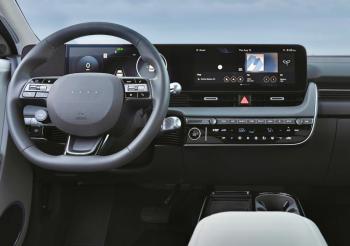 Improvements to the Ioniq 5 for 2025 include physical buttons for often-used functions and next-generation connectivity and electronics. The touchscreen can be configured to show battery charge and mileage as well as the location of the nearest charging station. The lower of the two knobs behind the steering wheel is the gear selector.
Improvements to the Ioniq 5 for 2025 include physical buttons for often-used functions and next-generation connectivity and electronics. The touchscreen can be configured to show battery charge and mileage as well as the location of the nearest charging station. The lower of the two knobs behind the steering wheel is the gear selector.
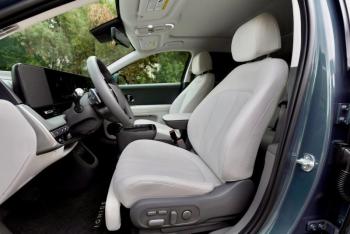 A loaded Ioniq 5 very nearly qualifies as a luxury car. Note the extendable footrest; the passenger front seat has one too. Both front seats also recline—perhaps for a quick nap while the car is plugged in at a charging station on the highway.
A loaded Ioniq 5 very nearly qualifies as a luxury car. Note the extendable footrest; the passenger front seat has one too. Both front seats also recline—perhaps for a quick nap while the car is plugged in at a charging station on the highway.
It’s hard not to be impressed by the Ioniq 5. Even EV haters are captivated by its silent swoosh of torque—one of the things everyone likes about electric cars. As a hatchback with its wheels shoved out to the corners, the batteries dropped into the floorpan and nicely weighted steering, the Ioniq 5 is also nimble and responsive but firmly planted and reassuring. Especially in Limited trim, it’s well equipped, too.
Our sample Ioniq 5 has all-wheel drive, which means an electric motor on each axle, driving the front and rear wheels separately but synchronously. Together, the motors are rated for 320 horsepower and 605 Newton-metres, 446 pound-feet, of torque. Since electric motors deliver power near-instantly—unlike internal-combustion engines, which need to rev up—the two-motor I-5 launches off the line like a fighter jet catapulted from an aircraft carrier. But quietly.
As virtually all EVs do, the Ioniq 5 offers one-pedal driving: Lifting off the accelerator can produce active braking by connecting the wheels to a generator that converts friction back to electricity that’s fed to the batteries. The degree of regenerative braking can be adjusted from none to a lot via paddles on the steering wheel. (On a fossil-fuel car, these paddles change gears, but few EVs have transmissions.) One-pedal driving is intuitive: Push to go, lift to stop, like a golf cart; the driver almost never needs the brake pedal.
Everyone frets about range, so for 2025 Hyundai did something about it. The two-motor Limited now has an 84 kilowatt-hour battery rated for up to 280 miles. (The rear-wheel-drive Ioniq 5 with a 225HP motor and the long-range battery is rated for up to 318 miles.) For what it’s worth, however, one warm morning our I-5’s computer boldly predicted 358 miles of range. We didn’t have time to run out that last mile, but later that day we learned that topping up from 76% to 100% would take 27 hours plugged into a normal wall socket, but only two hours and 17 minutes on the Level II fast charger in our garage. With a commercial Level III charger, this would take only a few minutes.
The Ioniq 5 is the first Hyundai to come with a NACS (North American Charging Standard) port, which means it can use Tesla’s 17,000-plus Superchargers without an adapter. This doubles the size of the available fast-charging network. To plug into our Emporia home charger, however, does require a CCS, Combined Charging System, adaptor, which Hyundai provides.
The Ioniq 5 is also the first Hyundai built at HMGMA—Hyundai Motor Group Metaplant America—in Georgia. (The one in the southeastern U.S., not the one between Europe and Asia.) This qualifies the car for tax incentives and federal credits, at least so far.
For 2025, Hyundai refreshed the car, which debuted only three years ago, with interior changes that include buttons instead of screen icons for some comfort features and the parking assist. The entire infotainment system has been brought to next-gen status and now can be upgraded OTA, over the air, wirelessly and without visiting a dealer. In addition, the phone charging pad has been relocated and the rear window now has a washer/wiper.
Hyundai also has introduced an alphabet soup of new safety and convenience features, including an HOD (Hands-On Detection) steering wheel and something called PCA-R/F/S, which stands for Parking Collision-Avoidance Assist - Reverse / Forward / Side. The 2025 Ioniq 5 also has Gen-2 Lane Following Assist, Remote Smart Parking Assist and the Hyundai Digital Key. There’s a long list of other safety aids as well as available deluxe features that range from a power liftgate and reclining front seats to a head-up display for the driver.
Our loaded AWD Limited Ioniq 5 bears a sticker price of $59,000+, but the base-level SE starts at $15,000 less than that. Hyundai now also offers a slightly lifted XRT, with some off-road capability, starting at $57,100, and there’s even a stealth-fighter Ioniq 5N with 641 horsepower, 220 miles of range and an MSRP of $66,200. These prices include some combination of credits for charging or a home charger installation.
Power, range, features, performance, comfort, safety, value . . . the Ioniq 5 seems to offer it all. But I want more. I want Hyundai’s luxury brand, Genesis, to dress up and re-badge the Ioniq 5. Don’t stretch the footprint and don’t mess up the performance and handling, but do ramp up the Wow! factor with prettier styling and a really swank cabin. Call it the Genesiss IQ-5. Oh, and please keep the MSRP well below $70K. Text me when it’s ready . . .
Next week: Ford F-150 Lightning

